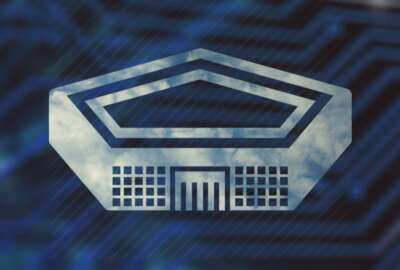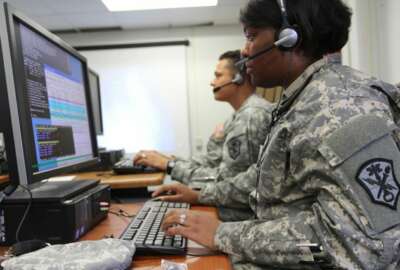DISA’s Skinner not a fan of ‘wooden shoe’ IT services
Lt. Gen. Robert Skinner, the director of the DISA, said DoDNet users must change their processes versus asking for unique IT services.
BALTIMORE — Air Force Lt. Gen. Robert Skinner, the director of the Defense Information Systems Agency, doesn’t have time for any wooden shoes.
No, he’s not taking a swipe at the Dutch and their almost 800 year old tradition of creating clogs.
Rather, Skinner, whose tenure as DISA director will be ending as soon as the Senate confirms his replacement, Maj. Gen. Paul Stanton, who currently leads the Army’s Cyber Center of Excellence, is talking about wooden shoes as a metaphor for IT services offered through the DoDNet. The DoDNet is the network consolidation initiative under the $11 billion contract award under the Defense Enclave Services and Fourth Estate optimization initiatives.

“We take a best of breed offering, so let’s take identity, for example, or let’s take networking or let’s take applications, and we’re developing an application that is best for the enterprise. A lot of times services, and even some agencies, have, they say, unique requirements that they want to make sure that as part of this. Well, whenever you add a unique requirement to an enterprise solution, it’s suboptimizes that enterprise solution,” Skinner said during a press conference after speaking at the AFCEA TechNet Cyber conference on June 26. “So really, what we’re saying is, you have to change your processes to leverage this environment. Our focus, as a combat support agency, has to be on the combatant commands, who are the warfighters. So our focus is on them and the agencies because that’s what we’ve been tasked and that’s what our mission is. I would love to have the services consume more DISA services and capabilities, that would be great because then as the services and the service components are supporting those combatant commands, they are all leveraging the same capabilities.”
Skinner said the unique requirements that the military services say they need are those wooden shoes, where no two pairs are the same.
DISA taking on software licensing
A prime example of this wooden shoe problem is how the Defense Department set up the unclassified version of Office 365. Across all of DoD, there are 14 different and distinct tenants.
Skinner said DoD is not making that same mistake with the classified or secret version of O365 where everyone will use one instance.
“If you’re a Marine, for example, that is a working at the Marine Corps headquarters and then you go to Cyber Command, and you go to a joint tenant, you have to move your data and move your stuff to this new tenant versus it all being in one tenant already,” he said. “As we lay this framework of cloud identity, networking applications, it’s really for the greater good, and I would offer sometimes the organization’s need to change your process, even it’s just a little bit, to consume it versus saying, we have this unique requirement that and we’re going to use that as a as a reason for not supporting an enterprise capability.”
The other challenge is the cost of licensing the software in the distinct tenants. That issue came about under the DISA Defense Enterprise Office Solutions (DEOS) contract where software licenses could cost as much as 20% higher.
DISA is leading an effort to address this higher cost of software licenses as well as part of this overall DoDNet effort.
“I’m a big proponent of DoD purchasing power that if you’re using, we’ll just say Microsoft, for example, everybody should be paying the same price for the same capabilities, whether it’s Microsoft or ServiceNow [or any other provider]. But from a department standpoint, we have more purchasing power when we’re all aligned” he said. “Same thing to me from a collaboration interoperability standpoint, the more that we’re leveraging the same capabilities, the easier it is to be more proficient and quicker. If I’m a soldier, sailor, airman, Marine or guardian, who is a network operator, for example, and I’m going from a joint position to a service position and back to a joint position, if you’re using common capabilities, then you can be proficient faster as you go into that new position.”
DoDNet ready for expansion
Skinner said the DoD CIO’s board is working on three or four enterprise licenses deals to show the services the potential savings as a way to gain some traction for this effort.
“The other thing that we’re working with the department at the DoD level, is to say, ‘hey, for licenses, why don’t we just take it off the top?’ So instead of a service having to take it [out of their budget,] why don’t we just take it off the top and therefore services don’t have to worry about it?” Skinner said. “Well, as a service, I’m actually paying more than what I did before because they didn’t get as good a deal. But because I’m part of this enterprise license, let’s just take it off the top. So that’s another area that we’re working within the department.”
In the meantime, DISA continues to expand DoDNet and its capabilities.
Miguel Cerritos-Aracen, the DoDNet operations chief for DISA, said during an AFCEA TechNet Cyber panel that they are ready to expand beyond the three current customers, DISA, the Defense Technical Information Center and the Defense POW/MIA Accounting Agency (DPAA).
Cerritos-Aracen said about he expects the 30,000 current users of common IT services on the unclassified and secret tenants to increase to more than 300,000 in the next year or so.
“Right now, we’re working with, for example, the Defense Media Activity, the Defense Contract Audit Agency, the Defense Contract Management Agency, Defense Microelectronics Activity and others,” he said. “That’s also why it’s so important that we take advantage of things of new technologies like automation and things of that nature. Our latest partners have actually brought in more solutions that have removed some of the legacy technologies of our environment, and actually allowed us to be on the precipice to be more advanced. In addition to that, some of the other achievements that we did just last year, as an example, is we did retire some legacy environments. For example, in DISA we had a corporate network called DISANet. I actually put to bed because we were able to move on into DoDNet.”
DISA’s Thunderdome included in DoDNet
Additionally, Cerritos-Aracen said by moving to DoDNet, its customers are now using Windows 11 across both unclassified and classified platforms, and are using new applications through O365 that they previously didn’t have access to and allows for more collaboration on the secret side.
Chad Buechel, a vice president for Leidos, which is the lead contractor for DoDNet, said at the end of May or early June, DoDNet reached initial operating capability for some of those new technologies and capabilities, such as virtual desktop-as-a-service and unified end point management, which lets DISA more effectively manage customer end points and protect them from cyber threats.
He said it’s all about making it easier for users to migrate and then use DoDNet.
DISA expects to continue to expand DoDNet to the combatant commands starting in fiscal 2026.
Cerritos-Aracen said DISA also is integrating its zero trust architecture under Thunderdome as part of DoDNet to include a secure access service edge (SASE) and software-defined wide area network (SD-WAN) capabilities.
Copyright © 2024 Federal News Network. All rights reserved. This website is not intended for users located within the European Economic Area.
Jason Miller is executive editor of Federal News Network and directs news coverage on the people, policy and programs of the federal government.
Follow @jmillerWFED






